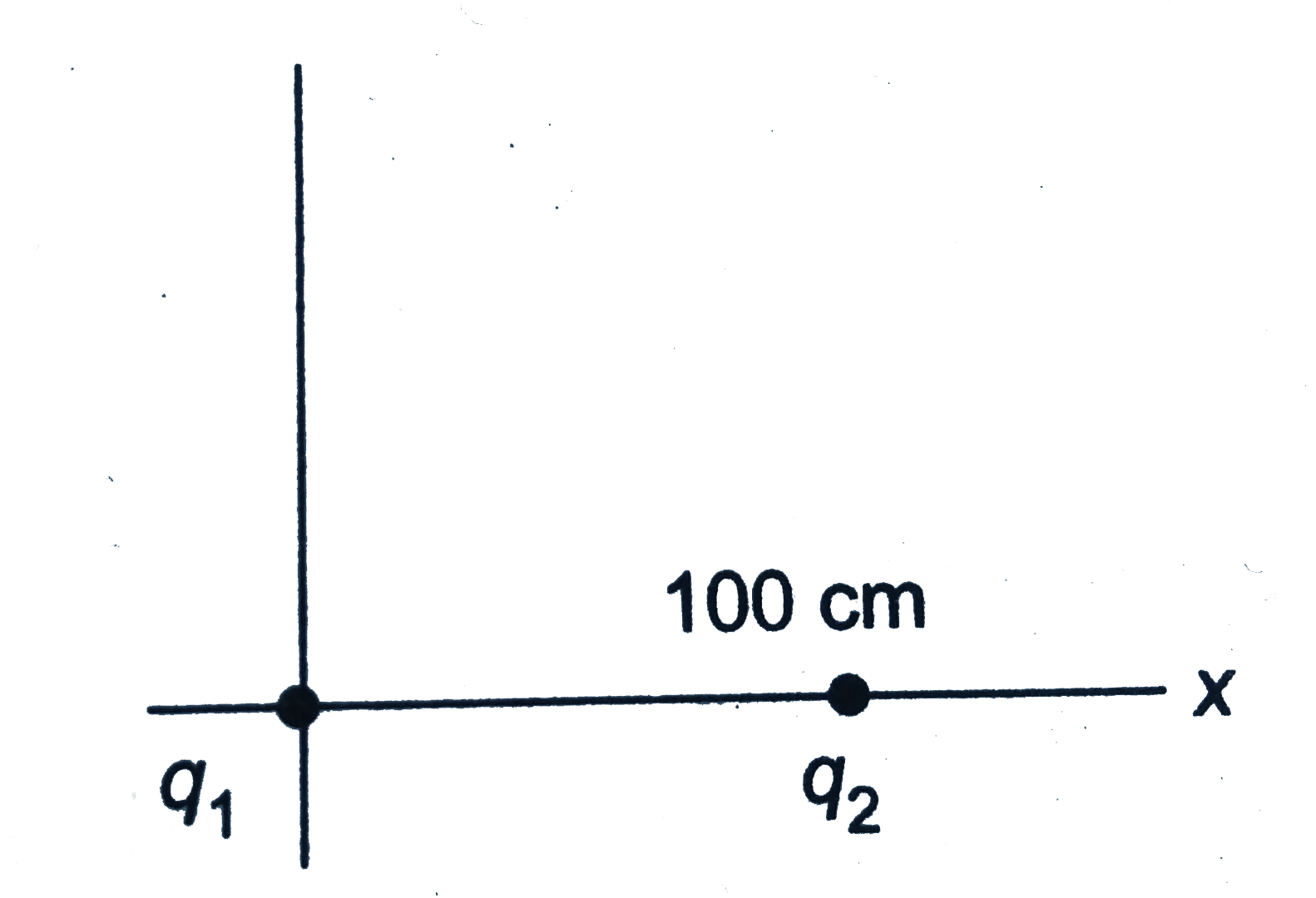A point charge q1=−5.8μC is held stationary at the origin. A second point charge q2=+4.3μC moves from the point (0.26m0,0) to (0.38m,0,0). How much work is done by the electric force on q2?
The correct Answer is:B
To find the work done by the electric force on the charge q2 as it moves from its initial position to its final position, we can use the concept of electric potential energy. The work done by the electric force is equal to the negative change in potential energy.
1. Identify the Charges and Positions:
- The stationary charge q1=−5.8μC=−5.8×10−6C is located at the origin (0, 0, 0).
- The moving charge q2=+4.3μC=4.3×10−6C moves from the initial position (0.26m,0,0) to the final position (0.38m,0,0).
2. Calculate the Initial and Final Distances:
- The initial distance ri from q1 to q2 is:
ri=0.26m
- The final distance rf from q1 to q2 is:
rf=0.38m
3. Calculate the Electric Potential Energy:
- The electric potential energy U between two point charges is given by:
U=kq1q2r
- Where k is Coulomb's constant, k=9×109N⋅m2/C2.
4. Calculate Initial Potential Energy Ui:
Ui=kq1q2ri=9×109⋅(−5.8×10−6)(4.3×10−6)0.26
5. Calculate Final Potential Energy Uf:
Uf=kq1q2rf=9×109⋅(−5.8×10−6)(4.3×10−6)0.38
6. Calculate the Work Done W:
- The work done by the electric force is given by:
W=−(Uf−Ui)=Ui−Uf
7. Substituting Values:
- Calculate Ui and Uf:
Ui=9×109⋅(−5.8×10−6)(4.3×10−6)0.26≈−0.272J
Uf=9×109⋅(−5.8×10−6)(4.3×10−6)0.38≈−0.187J
- Now calculate W:
W=−(−0.187−(−0.272))=0.272J
Final Answer:
The work done by the electric force on q2 is approximately 0.272J.
---
- The stationary charge q1=−5.8μC=−5.8×10−6C is located at the origin (0, 0, 0).
- The moving charge q2=+4.3μC=4.3×10−6C moves from the initial position (0.26m,0,0) to the final position (0.38m,0,0).
- The initial distance ri from q1 to q2 is:
ri=0.26m
- The final distance rf from q1 to q2 is:
rf=0.38m
- The electric potential energy U between two point charges is given by:
U=kq1q2r
- Where k is Coulomb's constant, k=9×109N⋅m2/C2.
Ui=kq1q2ri=9×109⋅(−5.8×10−6)(4.3×10−6)0.26
Uf=kq1q2rf=9×109⋅(−5.8×10−6)(4.3×10−6)0.38
- The work done by the electric force is given by:
W=−(Uf−Ui)=Ui−Uf
- Calculate Ui and Uf:
Ui=9×109⋅(−5.8×10−6)(4.3×10−6)0.26≈−0.272J
Uf=9×109⋅(−5.8×10−6)(4.3×10−6)0.38≈−0.187J
- Now calculate W:
W=−(−0.187−(−0.272))=0.272J
The work done by the electric force on q2 is approximately 0.272J.
Topper's Solved these Questions
- BOOK - DC PANDEY ENGLISHCHAPTER - ELECTROSTATICSEXERCISE - Exercise 24.14videos
ELECTROSTATICS
- BOOK - DC PANDEY ENGLISHCHAPTER - ELECTROSTATICSEXERCISE - Exercise 24.29videos
ELECTROSTATICS
- BOOK - DC PANDEY ENGLISHCHAPTER - ELECTROSTATICSEXERCISE - Example Type 83videos
ELECTROSTATICS
- BOOK - DC PANDEY ENGLISHCHAPTER - ELECTROSTATIC POTENTIAL AND CAPACITORSEXERCISE - (C) Chapter exercises50videos
ELECTROSTATIC POTENTIAL AND CAPACITORS
- BOOK - DC PANDEY ENGLISHCHAPTER - GRAVITATIONEXERCISE - All Questions135videos
GRAVITATION
Similar Questions
A point charge q1=−5.8μC is held stationary at the origin. A second point charge q2=+4.3μC moves from the pont (0.26m0,0) to (0.38m,0,0). How much work is done by the electric force on q2?
View SolutionA point charge q1=−1.0μC is held stationary at the origin. A second point charge q2=+2.0μC moves from the point (1.0m,0,0) to (2.0m,0,0). How much work is done by the electric force on q2?
View SolutionA point charge q1=+2.40μC is held stationary at the origin. A second point charge q2=−4.30μC moves from the point x=0.150 m, y=0 to the point x=0.250 m, y=0.250 m. How much work is done by the electric force on q2?
View SolutionA point charge q1=1.0μC is held fixed at origin. A second point charge q2=−2.0μC and a mass 10−4 kg is placed on the x-axis, 1.0 m from the origin. The second point charge is released from rest. What is its speed when it is 0.5 m from the origin?
View SolutionA point charge q1=9.1μC is held fixed at origin. A second point charge q2=−0.42μC and a mass 3.2×10−4kg is placed on the x-axis, 0.96m from the origin. The second point charge is released at rest. What is its speed when it is 0.24m from the origin?
View SolutionA point charge q1=9.1μC is held fixe at origin. A second pont charge q2=−0.42μC and a mass 3.2×10−4kg is placed on the x-axis, 0.96m from the origin. The second point charge is released at rest. What is its speed when it is 0.24m from the origin?
View SolutionA point charge q1=4.00nC is placed at the origin, and a second point charge q2=−3.00nC, placed on the x-axis at x = + 20.0 cm. A third point charge q3=2.00nC is placed on the X-axis between q1,andq2. (Take as zero the potential energy of the three charges when they are infinitely far apart).
(a) What is the potential energy of the system of the three charges if q3 is placed at x= + 10.0 cm?
(b) Where should q3 be placed to make the potential energy of the system equal to zero?View SolutionA point charge q1 is held stationary at the origin. A second charge q2 is placed at a point a, and the electric potential energy of the pair of charges is −6.4×10−8J. When the second charge is moved to point b, the electric force on the charge does 4.2×10−8J of work. What is the electric potential energy of the pair of charges when the second charge is at point b?
View SolutionA point charge q1=+2μC is placed at the origin of coordinates. A second charge, q2=−3μC, is placed on the x-axis at x=100cm. At what point (or points) on the x-axis will the absolute potential be zero?
 View Solution
View SolutionA point charge q=−8.0nC is located at the origin. Find the electric field vector at the point x=1.2m,y=−1.6m.
View Solution

